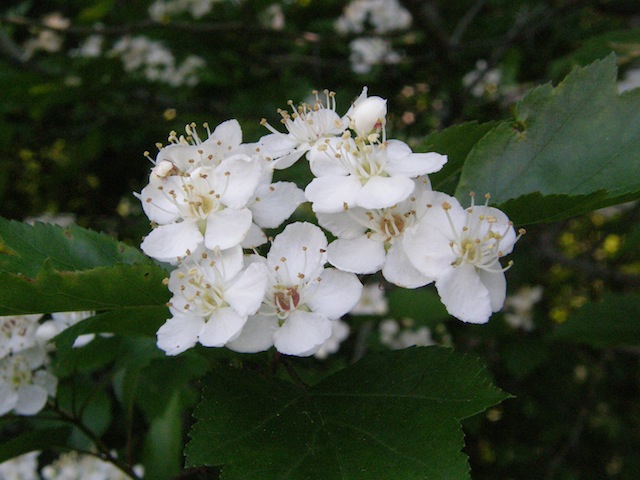Rosaceae, the rose family.
Description:
Plant:
Large group of small trees and woody shrubs, most with crooked, thorny branches, and
variously toothed and lobed leaves.
Small clusters of white to pink apple-like flowers appear in spring.
Fruit a small, dry applet, with a few woody seeds, often bright red, ripening in fall.
Flowers:
White to sometimes pink, with five petals in the wild versions, five sepals,
and 5-20 stamens, 3/4"-1".
Appearing in spring after the leaves
The flowers occur in small clusters.
Often planted ornamentally or in hedgerows.
Leaves:
Alternate, ovate, variously toothed or lobed with short petioles.
Leaves near ends of branches are often shaped differently than ones further in.
Fruit:
Small, usually red applets, 1/4"-1/2", ripening in fall.
Dry and seedy, most not appealing as human food, but eaten by a variety of birds.
Blooming:
April-May
Habitat:
Forest boundaries and open woods to fields and thickets.
Comments:
The hawthorns are a large genus widely distributed in temperate Europe, Asia, and
particularly eastern North America. They are distinctive as a group, but difficult
to assign to species. Well over 100 species have been described in Eastern North America alone,
but current thinking is that many of these are probably better considered local varieties or
hybrid forms. The specific nomenclature remains unsettled.
Hawthorns are closely related to the apples (genus Malus).
The fruits are usually small, dry, and not very palatable to humans though some varieties
are used to make jelly or relishes.
However, they are an important food source for birds and some small mammals.
The thorny branches can form an almost impenetrable barrier when growing in a thicket or
planted as a hedgerow.
Where to find it:
In a few locations along the forest boundary. Not nearly as common as the several varieties of
crab apples in the park.
